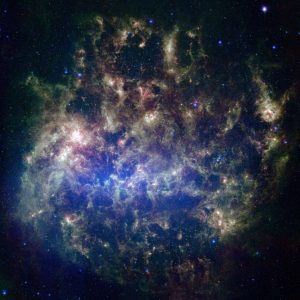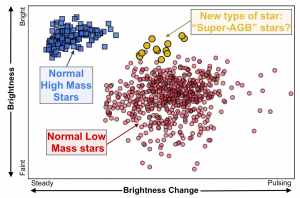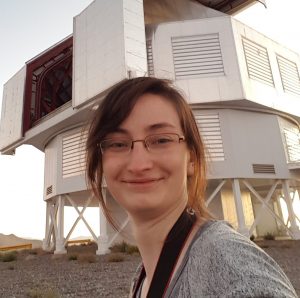
The Large Magellanic Cloud, a nearby galaxy in which astronomers have identified an unusual population of stars. (Credit: NASA/JPL-Caltech/M. Meixner & SAGE Legacy Team)
A University of Toronto PhD student has led the discovery of a population of a rare type of star – research that can help us to better understand what types of stars explode, and could potentially expand our understanding of the contents of the Universe.
Anna O’Grady – an astronomy PhD student in the David A. Dunlap Department of Astronomy & Astrophysics and the Dunlap Institute for Astronomy & Astrophysics – specializes in the study of stars in nearby galaxies. After an extensive study of brightnesses and temperatures, she and her colleagues seem to have confirmed the existence of a new type of star called “super asymptotic giant branch stars,” or super AGB stars for short.
O’Grady says this new data is important to better understand how stars end their lives, sometimes in huge explosions. “We’re not really sure what the dividing line is between low-mass stars like the Sun (which don’t explode) to high-mass stars (that do explode),” O’Grady explains, “so finding a population of these super AGB stars, which sit at a mass on the dividing line, is really exciting.”
O’Grady’s research has been published in a paper in The Astrophysical Journal. Professor Bryan Gaensler is an author on the paper, and is also one of O’Grady’s co-supervisors. He says her research is incredibly valuable.
“This was extremely careful and clever detective work on Anna’s part,” he notes. “She started by studying 1.5 million stars, and was able to identify 12 extremely unusual stars that are hard to explain. I’m excited about what more we can learn about this strange population from additional data.”
O’Grady and her team are already heavily involved in the next steps of this research. They’re taking a deeper look at the possible super-AGB stars they’ve identified by studying their local environments, and they’re also looking into the elements that are present within their atmospheres.
Most interestingly, the potential outcomes of these next research steps could help us to answer some bigger astronomical questions. “If you can understand at what mass a star explodes,” O’Grady says, “you can also get closer to understanding the amount of heavy elements you expect to see in the Universe.”

A modified plot from O’Grady’s paper, showing the brightness properties of the super-AGB candidates. Credit: Anna O’Grady.
Associated Publication Info:
O’Grady, Anna J. G.; Drout, Maria R.; Shappee, B. J.; Bauer, Evan B.; Fuller, Jim; Kochanek, C. S.; Jayasinghe, T.; Gaensler, B. M.; Stanek, K. Z.; Holoien, Thomas W.-S.; Prieto, J. L.; Thompson, Todd A. Cool, Luminous, and Highly Variable Stars in the Magellanic Clouds from ASAS-SN: Implications for Thorne-Żytkow Objects and Super-asymptotic Giant Branch Stars, The Astrophysical Journal. https://ui.adsabs.harvard.edu/abs/2020ApJ…901..135O/abstract
For more information, please contact:
Meaghan MacSween
Communications and Multimedia Officer
Dunlap Institute for Astronomy & Astrophysics,
University of Toronto
meaghan.macsween@utoronto.ca
The Dunlap Institute for Astronomy & Astrophysics at the University of Toronto is an endowed research institute with more than 90 faculty, postdocs, students and staff, dedicated to innovative technology, ground-breaking research, world-class training, and public engagement. The research themes of its faculty and Dunlap Fellows span the Universe and include: optical, infrared and radio instrumentation; Dark Energy; large-scale structure; the Cosmic Microwave Background; the interstellar medium; galaxy evolution; cosmic magnetism; and time-domain science. The Dunlap Institute for Astronomy and Astrophysics, David A. Department of Astronomy & Astrophysics and the Canadian Institute for Theoretical Astrophysics comprise the leading centre for astronomical research in Canada, at the leading research university in the country, the University of Toronto.

